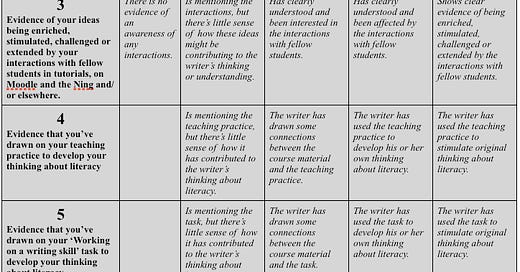ELPC 4: And finally, a rubric
This morning I've been working on a rubric for the journals referred to in the earlier posts in this series. I don't like marking with rubrics (but then I don't like marks much!), but I do find rubrics useful as a way of exposing my values and criteria to my students. It's good to talk about draft rubrics.
So here's the one I've come up with this morning.
This is going to be of more interest to my students than to other readers, though Karen, Dan and Elfarran will notice their fingerprints on this one.
Sorry about the size of the print.
And here are the notes I want to attach to this rubric, for us to talk about in our first tutorial.
Notes:
1. The final journal submission has a word limit of 2000 words. This is twice the word limit of the last journal assessment submission.2. Your 2000 words can be in the form of extracts culled from your ongoing journal, or in the form of a 2000 word paper, drawing ideas and material from your journals, tutorials, reading, interactions with students and teaching practice.
3. I will be asking myself a series of specific questions when I read these 2000 words. These are:
Has this student made it clear what he/she sees as his/her ‘core disciplinary business’? Does he/she see this in terms of (i) the traditional historically approved version? (ii) his/her personal heart-of-heart version? (iii) the radically transformed literacy landscape we now live in version?
Has the student made it clear that he/she has become informed about the current debate about literacy in general and writing in particular?
Has this student thought through any implications a redefining of writing would have on his/her philosophy and pedagogy?
4. You’ll notice that this time I’ve put ‘contact with staff’ in with ‘reading’. Last time ‘contact with staff’ was in with ‘interactions with students’. It didn’t sit well there, as many of you wanted to talk about Tovani and Prof Lowe together.
5. It is my hypothesis (obviously shared by many of you) that feeling a sense of belonging to a vibrant and stimulating community is a key in the development of successful literacy skills. Criteria 3 is there to give you an opportunity to reflect on this aspect. If the ELPC G2 community has been stimulating, here is an opportunity to discuss this. If, on the other hand, you disagree with my hypothesis, here is an opportunity to challenge it. 6. Criteria 4 & 5 are not compulsory. You do not have to address these in your 2000 words. But they have been included in the rubric because, for some of you, the teaching practice and/or the Writing Skill Task will have made a significant contribution to your thinking about literacy.





